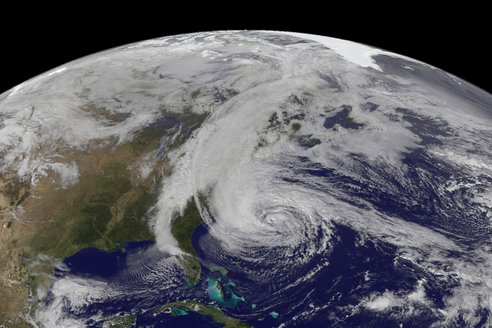On an average day, New Jersey and New York harbor have some of the busiest ports, importing and exporting goods on the Eastern seaboard; but, this Monday morning, Oct. 29th, was different.
The marine terminals weren’t busy with dockworkers bustling to unload shipping containers from laden cargo ships. Hurricane Sandy arrived and port authorities took the wise precaution of evacuating New Jersey ports by Monday afternoon.
At the time of this writing, Hurricane Sandy has already made landfall on the north east coast around New Jersey and is working its inexorable way further north and inland poised to wreak havoc on one of the most densely populated regions in the US. The storm hit the southern Jersey shore around 8 pm East Coast time but storm conditions have been affecting the coast for several days already.
Having had warning about the storm has enabled authorities to ameliorate the danger to life and limb caused by Hurricane Sandy. But what about the economic impact of what has been dubbed the “Frankenstorm”? Several articles have already been published discussing the effect Hurricane Sandy will have on the economy in general, giving us clues as to how Sandy may affect international shipping in the US specifically.
A recent Chicago Tribune article assures us that the long-term effect of Sandy on the economy should be neutral on a national scale. This is because the cost of rebuilding and repairing the damage of the storm should pump money back into the economy roughly equal to that lost. The authors point to Hurricane Katrina as an example of this sort of equalization as the recovery efforts balanced out the cost of the damages to infrastructure.[1] (The loss of life and the psychological toll caused by Katrina are, of course, a different story).
A USA Today article noted that some businesses even prosper from the storm on account of residents making storm-preparation purchases.[2] But what about the more localized damage such a storm can cause, especially to East Coast ports and those in the international shipping business?
Reuters reported that some ports will be shut “indefinitely” but it also noted that the economic impact “probably won’t be large.”[3] Stranded cargo is unlikely to sustain damage but delivery will be delayed, with some companies estimating it will take at least an extra 72 hours for goods to arrive.
Freight forwarders are scrambling to reroute their shipments to avoid ports affected by the storm.[4] Overland transport from seaports is likely to be slowed down for days as storm damage blocks roads. Relief efforts will focus on getting essential food and medical supplies to hurricane victims rather than clearing roads for commercial transport. [5] Also many bridges and roads in New York are already closed to truck transport for fear of the damage wind could do to such vehicles and will remain closed to freight transport until the storm has passed.[6]
Air transport too is likely to suffer setbacks as air traffic grinds to a halt in many East Coast locations, stranding goods and passengers alike until Sandy passes.
It seems to me that economists’ positive predictions (like this one by Peter Morici[7]) about the long term recovery and even benefits that come from weathering a storm with the destructive force of Hurricane Sandy are flawed. Such a view may work on the broad scale, if you are a state or federal government. But it really ignores the potential devastation to an individual who loses their home or the revenue loss of several million dollars a day for carriers and freight forwarders due to ports being closed and goods not delivered on time.
How has Hurricane Sandy affected you personally? Do the reassurances about long-view economic stimulus generated by storms like Sandy ring true? Let us know in the comments section below.
